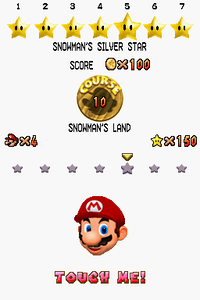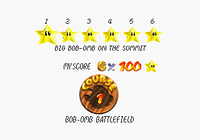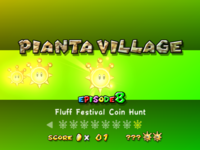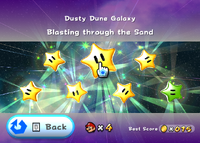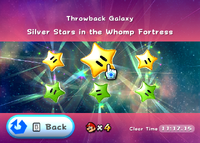Mission
- This article is about sections of gameplay in 3D Super Mario games. For other uses, see Mission (disambiguation).
Missions, also known as episodes in Super Mario Sunshine and objectives in Super Mario Odyssey, appear as scenarios or instances that take place in various levels in many of the 3D games in the Super Mario series. Missions often change the placement of objects in the level they apply to, and lead the player toward a certain Power Star, Shine Sprite, or Power Moon in the level. In most of their appearances, missions are selected from a dedicated menu that appears upon the player entering a level.
History[edit]
Super Mario series[edit]
Super Mario 64 / Super Mario 64 DS[edit]
Missions first appear in Super Mario 64. There are six missions in each of the game's 15 main courses, which can be selected from when Mario enters one of the courses. Incomplete missions are represented by translucent blue Power Stars, while completed ones are represented by yellow Power Stars. Mario can select only the first mission in each course when he enters it for the first time. Individual missions only rarely contain differences in level design in this game, mostly limited to the appearance of mission-relevant characters or bosses, such as the Big Bob-omb appearing only when Big Bob-omb on the Summit is selected on the Bob-omb Battlefield, though there are occasionally more subtle differences as well, such as there being three iron balls rolling around in a ditch on the Bob-omb Battlefield during Footrace with Koopa the Quick as opposed to two in every other mission. Since the level design changes little between missions, Power Stars belonging to missions other than the one selected can be obtained the majority of the time. Collecting a Power Star from a later mission causes only that mission to become unlocked prematurely.
Each of the main courses also contains an additional Power Star that appears regardless of the selected mission once Mario collects 100 coins in a single visit to that level. These Power Stars are not themselves part of any mission, and they are listed separately in mission selection menus.
In Super Mario 64's remake, Super Mario 64 DS, missions function largely the same, though there are now seven missions in each main course instead of six. While Power Stars from other missions can still be obtained the majority of the time, there are a slightly greater number of level design changes between missions than in the Nintendo 64 version. For example, the newly introduced Silver Stars appear only when the missions they are relevant to are selected.
Super Mario Sunshine[edit]
In Super Mario Sunshine, there are eight proper episodes in each of the seven main levels, which can be selected from upon entering a level. Each episode is represented by a translucent blue Shine Sprite if it is incomplete, and a golden one if it has been completed. Like in Super Mario 64, episodes are unlocked in order starting with the first. Compared to Super Mario 64, however, there are far more level design changes between episodes, with the placement of enemies, coins, terrain features, interactive objects, friendly characters, goop, and even trees regularly varying from one episode to the next. Friendly characters also typically have different dialogue between episodes, usually forming an ongoing narrative that plays out through the episodes of each level. Due to the greater variance between episodes, it is usually impossible to obtain episode-based Shine Sprites other than the one that pertains to the selected episode. There are several exceptions to this, however, most notably the case of being able to complete Episode 2 of Bianco Hills (Down with Petey Piranha!) while Episode 1 (Road to the Big Windmill) is selected. Unlike in Super Mario 64, this unlocks the episode numbered after the one that was collected out of order, allowing further episodes to be selected out of order. It is also possible to collect the Shine Sprites from Bianco Hills' Episode 3 (The Hillside Cave Secret) and Episode 6 (The Secret of the Dirty Lake) in later episodes, though doing so does not allow the player to skip anything. The Shine Sprite for Episode 8 of Gelato Beach (The Watermelon Festival) can also be collected early in any of the other episodes through a glitch, as it is always visible inside a glass tank in the Surf Cabana. If this is done, all intervening episodes between the one in which the Shine Sprite was collected and The Watermelon Festival are also unlocked, and can be selected from then on.
Completing the seventh episode of each main level is mandatory to finish the game, as doing so unlocks the entrance to Corona Mountain in Delfino Plaza. Each of these seventh episodes involves chasing Shadow Mario through the level and defeating him.
The Super Mario Sunshine Player's Guide also refers to the two hidden Shine Sprites in each level as being collected as part of ninth and tenth episodes of their respective levels.[1] However, these episodes are not selectable from the episode selection menu even after being completed, instead being displayed in the margin of the menu next to text reading "???" These hidden Shine Sprites are obtainable by selecting certain episodes and then somehow exploring off of the main path. Some of these hidden Shine Sprites are obtainable in multiple episodes, while others are limited to a single one. For example, Pianta Village's Soak the Sun Shine Sprite can be obtained by selecting Episode 8, Fluff Festival Coin Hunt, then spraying a hidden Shine Sprite painting at Pianta Village's highest point instead of collecting the eight red coins.
Like in Super Mario 64, each main level, as well as Delfino Plaza, the game's hub area, contains an additional Shine Sprite not part of any episode that appears in any episode once Mario collects one hundred coins. These Shine Sprites are once again not considered to be part of any particular episode, and are listed separately when selecting an episode.
Delfino Plaza, the game's hub area, and Delfino Airstrip, the introductory level, also contain multiple scenarios between them much like the main levels' episodes, differing in object placement and friendly character dialogue. These areas automatically switch between scenarios as Mario progresses through the story and collects more Shine Sprites, and earlier scenarios cannot be returned to on the same save file. The final scenario present in both is accessible once Mario returns from Corona Mountain for the first time (after defeating Bowser or otherwise).
Super Mario Galaxy[edit]
In Super Mario Galaxy, unlike in previous games, all 121 unique Power Stars in the game are designated as named missions. Each of the game's galaxies contains between one and three regular missions that are automatically unlocked in order similarly to previous games, and zero to four additional missions (for a total of between one and seven per galaxy). Some additional missions are hidden missions accessed by going off of the main path of one of the regular missions (often subsequent to feeding a Hungry Luma), similarly to Super Mario Sunshine's hidden Shine Sprites. Others are missions associated with Prankster Comets, which can only be selected while a Prankster Comet is in orbit of the galaxy unless the mission has been completed. Others still are accessible only after reading a letter sent by Luigi requesting that he be rescued in a specific galaxy, which function similarly to hidden missions once unlocked. Missions are selected through a menu when Mario or Luigi enters a galaxy similarly to the previous games, with incomplete missions represented by translucent Power Stars and completed missions represented by regular Power Stars, with the appropriate color in the case of Green Stars and the Red Power Star. Hidden missions that the player has not completed are indicated by a small "question mark star" icon displayed above the regular mission in which it can be obtained, if that regular mission has been completed; letter missions are displayed similarly, but only once the relevant letter has been received. While a Prankster Comet is in orbit of a galaxy, its respective mission is the only one that can be selected. Selecting a completed hidden mission or letter mission from the menu returns Mario or Luigi to the regular mission scenario in which the additional mission can be completed.
Level design and object placement varies between a galaxy's regular missions to an even greater degree than it does in Super Mario Sunshine, often leading Mario and Luigi to completely different planets in the galaxy, occasionally even with a different starting planet. Hidden missions and letter missions simply lead Mario and Luigi on branching paths away from the usual path in a mission, while Prankster Comet missions typically lead Mario and Luigi on a path that is a cut-down, altered version of one of the regular or hidden missions. Power Stars belonging to regular missions other than the one selected can never be obtained, unlike previous games.
Super Mario Galaxy 2[edit]
Missions in Super Mario Galaxy 2 function largely the same as those in Super Mario Galaxy, with each of the game's 242 unique Power Stars being designated as a named mission. In this game, galaxies contain only one or two regular missions, and one or two additional missions beyond that (for a total of two to three), which can once again be hidden missions, Prankster Comet missions, or letter missions (which are received from a variety of different characters in place of Luigi, such as a Gearmo in the Space Storm Galaxy and The Chimp in various other galaxies throughout the game). In addition to the two or three normal Power Star missions in each galaxy, there are an equal number of Green Star Prankster Comet missions in each galaxy except for the Grandmaster Galaxy, which are only unlocked once Mario and Luigi collect all 120 initially available Power Stars and complete the first mission of Bowser's Galaxy Generator, Bowser's Fortified Fortress. Unlike most missions which are named descriptively, Green Star missions are named Green Star 1, Green Star 2, and (if the galaxy has three Green Stars) Green Star 3 in every galaxy they appear in, and they are all unlocked at once. Green Star missions send Mario or Luigi to one of the galaxy's regular missions when selected, as the Green Stars occupy hidden locations in the galaxies in which they are found. As a result of the Green Stars' inclusion, each galaxy other than the Grandmaster Galaxy has a total of either four or six missions.
Like in Super Mario Galaxy, regular missions considerably vary from one another in terms of level design and object placement, usually leading Mario and Luigi to completely different planets in each mission. This is also the case for Prankster Comet missions to a greater degree than in Super Mario Galaxy, though many of them still reuse level design from the missions that they are based on. Additionally, while some letter missions, such as Boulder Bowl Galaxy's C'mere, Goomba, still take place in the scenario of one of the galaxy's regular missions, others, such as Fluffy Bluff Galaxy's The Chimp's Stomp Challenge, use unique, altered versions of a regular mission's scenario and are listed separately on the mission select screen before being completed, more closely resembling Prankster Comet missions.
Super Mario Odyssey[edit]
In Super Mario Odyssey, the role of missions is changed considerably. While all of the game's Power Moons have unique names much like missions in the previous games, they are, for the most part, not associated with specific missions, which there are between zero and five of in each of the game's kingdoms. Missions are the main story objectives in each kingdom, and usually require Mario to collect certain Power Moons and especially Multi Moons in order to be completed. Completing all missions in each kingdom aside from the Dark Side and Darker Side allows Mario to receive the Achieve World Peace Power Moon from Toadette in the Mushroom Kingdom. Completing story missions also usually changes the layout of the kingdom in some way, allowing Mario to access additional Power Moons and missions.
References[edit]
- ^ Averill, Alan, and Jennifer Villarreal (2002). Super Mario Sunshine Player's Guide. Nintendo of America (American English). ISBN 1-930206-23-2. Page 41.
